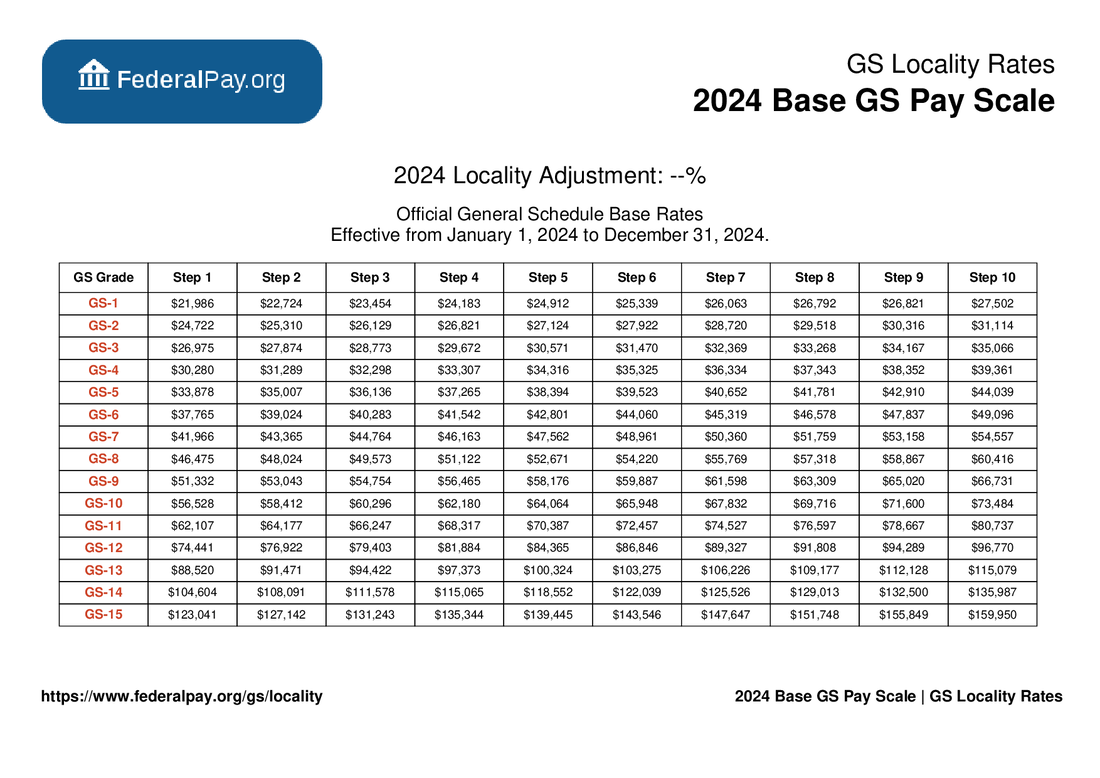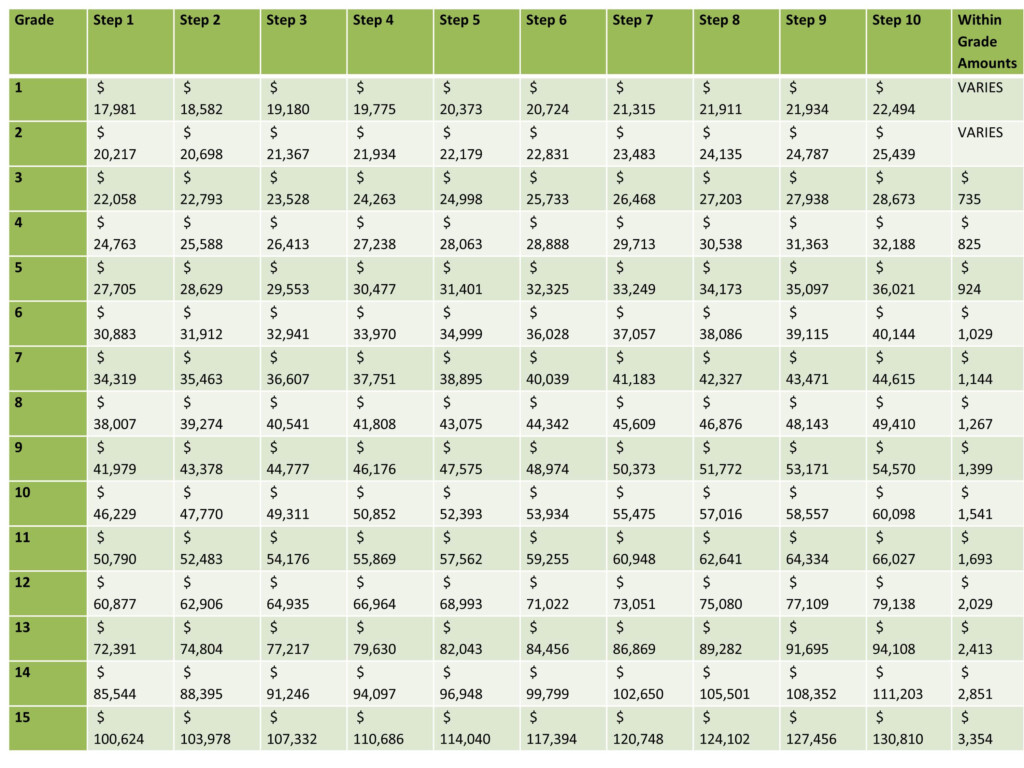GS Pay Explained! Your Guide To General Schedule Salaries
Are you leaving money on the table? Millions of federal employees might be, and understanding the General Schedule (GS) pay system is the first step to maximizing your earnings.The General Schedule (GS) payscale is the backbone of compensation for a vast number of federal civilian employees. It's a structured system designed to ensure fair and consistent pay across various roles, experience levels, and locations. Over 70% of the federal civilian workforce, encompassing more than 1.5 million individuals, rely on the GS payscale to determine their salaries. This system is not confined to a single city or state; it's a worldwide pay system, ensuring that federal employees across the globe are compensated according to a standardized framework.
The GS payscale isn't a one-size-fits-all solution. It's a nuanced system that takes into account several factors, primarily an employee's grade and step. Each agency within the federal government classifies its positions based on the level of difficulty, responsibility, and qualifications required. This classification determines the GS grade, ranging from GS-1 (typically entry-level positions) to GS-15 (highly specialized or managerial roles). Within each grade, there are 10 steps, representing increasing levels of experience and performance. As an employee progresses through these steps, their salary increases accordingly.To further refine the salary determination process, the U.S. Office of Personnel Management (OPM) has established General Schedule locality pay areas. These are regions across the United States where the cost of living is significantly higher than the national average. Employees working within these designated areas receive a locality pay adjustment (also known as a Cost of Living Adjustment or COLA) on top of their base GS pay. This adjustment ensures that federal employees can maintain a reasonable standard of living, regardless of the cost of goods and services in their specific location. For example, the 2025 locality pay adjustment for a high-cost area might be 33.94%, meaning that GS employees in that area earn 33.94% more than the standard GS base pay.Understanding the interplay between grade, step, and locality pay is crucial for federal employees who want to accurately estimate their potential earnings. Several online tools, such as the 2025 GS pay calculator, are available to help employees determine their exact salary. These calculators allow users to input their location, GS grade, and GS step to generate a personalized salary estimate. They are a valuable resource for both current and prospective federal employees.The GS pay schedule is typically updated annually to reflect changes in the cost of living and economic conditions. The 2023, 2024, and soon, the 2025 GS base pay tables serve as the foundation for calculating federal employee salaries. These tables outline the base pay rates for each grade and step combination, before locality adjustments are applied. Keeping abreast of these updates is essential for employees to understand how their salaries may change from year to year.The GS system also acknowledges that certain positions or locations may require specialized skills or present unique challenges. In these cases, special rate tables may apply. These tables provide higher rates of pay for specific occupations or geographic areas where recruitment and retention are difficult. For instance, other general schedule employees covered by this table whose pay rate at their grade and step on this table is below the rate for the same grade and step on an applicable special rate table under 5 U.S.C. 5305 (or similar special rate under other legal authority) are entitled to the higher special rate. This ensures that federal agencies can attract and retain qualified individuals in critical roles.The GS system is governed by a complex set of regulations and guidelines. Each agency classifies its GS positions and appoints and pays its GS employees filling those positions following statutory and OPM guidelines. General Schedule or GS means the classification and pay system established under 5 U.S.C. Chapter 51 and Subchapter III of Chapter 53. The term also refers to the pay schedule of GS rates established under 5 U.S.C. 5332, as adjusted under 5 U.S.C. 5303 or other law (including GS rates payable to GM employees). These regulations ensure that the system is applied fairly and consistently across the federal government.The GS payscale isn't the only pay system used by the federal government. Other pay schedules, such as the wage scale and special rates, are also utilized. However, the GS payscale is the most common, covering the majority of white-collar personnel, including professional, technical, administrative, and clerical positions. There are 343 job series that use the General Schedule (GS) payscale.To gain a deeper understanding of the GS system, it's helpful to explore specific job series and their associated pay rates. Click on any job series for job descriptions, starting and maximum base pay rates, and a list of current job openings within the series. For example, a nurse is part of the 0610 series.The higher the grade level, the higher the pay. And there are 10 steps within each grade. Typically internships, student jobs or lower level administrative work.To help navigate the complexities of the GS system, several resources are available online. The FederalPay GS Pay Calculator and other similar tools allow employees to estimate their salaries based on their grade, step, and location. These calculators provide a valuable resource for understanding the factors that influence federal employee compensation.The General Schedule (GS) payscale is a dynamic system that continues to evolve. As the federal government adapts to changing economic conditions and workforce needs, the GS payscale will likely undergo further adjustments. Staying informed about these changes is critical for federal employees who want to maximize their earnings and advance their careers. For more information about the structure of the XML files available below, please see the data dictionary. Each employee to whom this subchapter applies is entitled to basic pay in accordance with the general schedule. The rates of pay of the general schedule are and Find out how GS pay is calculated. Welcome to the general schedule salary calculator! Welcome to the federalpay gs pay calculator!



| Category | Information |
|---|---|
| Name | General Schedule (GS) Payscale |
| Description | The primary pay scale for United States federal government employees in white-collar positions. |
| Coverage | Over 1.5 million civilian employees of the United States government worldwide. |
| Percentage of Federal Employees | Used to calculate the salaries for over 70% of all federal government employees. |
| Governing Body | United States Office of Personnel Management (OPM) |
| Legal Basis | 5 U.S.C. Chapter 51 and Subchapter III of Chapter 53; 5 U.S.C. 5332, as adjusted under 5 U.S.C. 5303 |
| Structure | Grades (GS-1 to GS-15) with 10 steps within each grade. |
| Job Series | 343 job series that use the General Schedule (GS) payscale. |
| Salary Determination Factors | Grade, step, and locality pay adjustment. |
| Locality Pay Areas | Regions of the United States in which the OPM has determined that the cost of living is high enough to warrant additional compensation. |
| Special Rate Tables | Applicable in certain circumstances where specific skills or locations demand higher compensation. |
| Calculator Tool | FederalPay GS Pay Calculator |
- Claudia Heffner Peltz Model Wife Philanthropist Full Story
- Find Hindi Dubbed Movies Shows Online Your Guide

2025 Gs Pay Scale Rest Of Us Daisy K Hobbs

Understanding General Schedule (GS) Jobs Empire Resume

Gs Pay Scale For San Diego 2025 Rose Meldrum